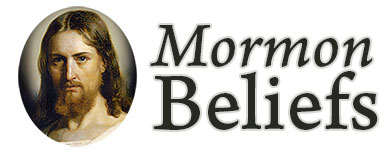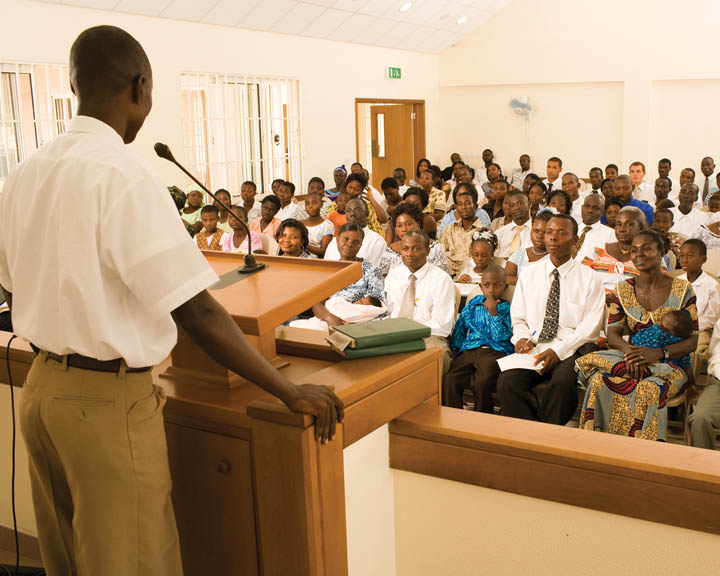 In June 1978, the priesthood in the Mormon Church was made available to all worthy male members, whereas up until that time, black Mormons of African descent had been denied the priesthood. The decision to extend the reach of the priesthood was made after much pleading to the Lord from the prophet. Following much prayer and fasting, the prophet received a profound revelation that the time had come.
In June 1978, the priesthood in the Mormon Church was made available to all worthy male members, whereas up until that time, black Mormons of African descent had been denied the priesthood. The decision to extend the reach of the priesthood was made after much pleading to the Lord from the prophet. Following much prayer and fasting, the prophet received a profound revelation that the time had come.
Said David B. Haight: “I was in the temple when President Spencer W. Kimball received the revelation regarding the priesthood. I was the junior member of the Quorum of the Twelve. I was there. I was there with the outpouring of the Spirit in that room so strong that none of us could speak afterwards. We just left quietly to go back to the office. No one could say anything because of the powerful outpouring of the heavenly spiritual experience. [1]
Said then-Apostle Gordon B. Hinckley:
I was present and was a participant and a witness to what occurred on Thursday, June 1, 1978. My memory is clear concerning the events of that day. Since we are commemorating the tenth anniversary of that historic event, I wish to give you my personal witness of what occurred. Each first Thursday of the month is a day for fasting and the bearing of testimony by the General Authorities of the Church. So many of the Brethren are absent from home on the first Sunday of the month because of assignments to stake conferences that we hold our monthly testimony meeting in an upper room of the Salt Lake Temple the first Thursday of the month. The Thursday of which I speak was June 1, 1978. We heard testimonies from some of the brethren, and we partook of the sacrament of the Lord’s Supper.
It was a wonderfully spiritual meeting, as are all such meetings in these holy precincts and under these circumstances. Then the members of the First Quorum of the Seventy and the Presiding Bishopric were excused, while there remained the president of the Church, his two Counselors, and ten members of the Council of the Twelve—two being absent, one in South America and the other in the hospital. The question of extending the blessings of the priesthood to blacks had been on the minds of many of the Brethren over a period of years. It had repeatedly been brought up by Presidents of the Church. It had become a matter of particular concern to President Spencer W. Kimball. Over a considerable period of time he had prayed concerning this serious and difficult question. He had spent many hours in that upper room in the temple by himself in prayer and meditation.
On this occasion he raised the question before his Brethren—his Counselors and the Apostles. Following this discussion we joined in prayer in the most sacred of circumstances. President Kimball himself was voice in that prayer. I do not recall the exact words that he spoke. But I do recall my own feelings and the nature of the expressions of my Brethren. There was a hallowed and sanctified atmosphere in the room. For me, it felt as if a conduit opened between the heavenly throne and the kneeling, pleading prophet of God who was joined by his Brethren. The Spirit of God was there. And by the power of the Holy Ghost there came to that prophet an assurance that the thing for which he prayed was right, that the time had come, and that now the wondrous blessings of the priesthood should be extended to worthy men everywhere regardless of lineage. Not one of us who was present on that occasion was ever quite the same after that. Nor has the Church been quite the same. [2]
The announcement was made by Prophet Spencer W. Kimball. The announcement was greeted with celebration and enthusiasm by Church members.
Even in 1978, a decade after the civil rights movement changed the face of America, worshipers in many churches across the land remained, in effect, segregated. Most blacks still worshipped with blacks, and most whites with whites. Few ordained black ministers preached to white congregations and discrimination in other forms still existed years later.
In fact, nothing like that happened in The Church of Jesus Christ of Latter-day Saints. There was never any policy of segregated congregations. Where Mormons of various racial or ethnic backgrounds have lived as neighbors, they have always worshiped together throughout Church history. Black Mormons had been baptized as members long before 1978 , had preached from the pulpit and offered prayers, even in largely white congregations—none of which required the member to hold priesthood office.
After announcing the change in June 1978, the Church immediately began ordaining active black Mormons to priesthood office wherever they attended throughout the world. The first temple in Africa was built in South Africa in 1981 and two more—in Ghana and Nigeria—were dedicated more recently. As of 2014, there were more than 420,000 members of the Mormon Church in Africa, many of them black Mormons.
The New York Times noted in a 2005 article that a new Church building in New York City was “one of the most racially integrated congregations in Harlem, with about equal numbers of white and black worshippers.”
Tony Parker, an African-American stake president, oversees nine congregations in the Atlanta area, including one headed by a black Mormon bishop. Parker has been a member of the Mormon faith for 25 years. “I’m a better person now than I was back then,” Parker says. “I feel better about myself. They have been years of personal growth and enrichment.” Parker says he has a simple answer to critics outside of the Church. “Anyone who thinks the Church is racist just needs to come and see. They can sit in our church on the sidelines and watch, or talk to members.” [3]
An account of two black Mormon converts:
An early African convert and pioneer is Anthony Obinna in Nigeria. He related the following story that occurred in the late 1960s: “One night I was sleeping and a tall man came to me [in a dream], took me to one of the most beautiful buildings, and showed me all the rooms.” In 1970 he read an article in an old 1958 Reader’s Digest titled “The March of the Mormons,” which included a picture of the Salt Lake Temple. “It was exactly the same building I had seen in my dream,” he said. Brother Obinna wrote to the Church for LDS literature.
In 1978, when the Obinna family learned of the revelation on the priesthood, they wrote to the First Presidency: “We are happy for the many hours in the upper rooms of the temple you spent supplicating the Lord to bring us into the fold. We thank our Heavenly Father for hearing your prayers and ours. . . . We thank you for extending the priesthood, . . . to prepare us to receive every blessing of the gospel.” When the missionaries arrived in Nigeria, they found many people prepared for the gospel as a result of Brother Obinna’s teaching and leadership. The first LDS chapel built in Nigeria is near the Obinnas’ home in Aboh Mbaise, of the Imo State.
Adjei Kwame was also prepared for the gospel and guided into the Church. He took a teaching position in Gweru, Zimbabwe, where he began to experience spiritual yearnings. “I had been searching for the true church,” he said. “I kept having dreams about a church building. When I went through Kwe Kwe, Zimbabwe, I saw it and wanted to go in to find out what kept coming into my dreams all the time.” When he went into the church building one Sunday, he felt that it was the true church and that he should join. “I felt that I was actually with some people that I knew a long time ago who had been good friends.”
When he first came to church, members of the Kwe Kwe Branch were bearing their testimonies. Brother Kwame went to the pulpit. He told the congregation that he believed in God and wanted to be a member of the Church. He later met with Sister Hamstead, the wife of the mission president. “What actually descended upon the two of us I cannot explain. I became aware that I was weeping. I can’t explain the feeling. I was released of all burdens. I felt that I had gone to a place where I visited often, but now I was at home.” [4]
For more information regarding black Mormons and blacks and the Mormon Church, visit LDS Genesis Group and BlackLDS.org.

